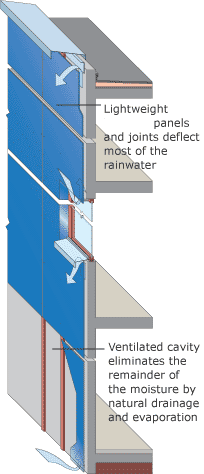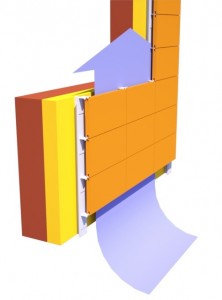What is Rainscreen Cladding and Why Do You Need It?
This entry was posted on Sep 5, 2015 by Richard FoulkesIf you’ve looked into putting new cladding on your home, then chances are you’ve been a bit baffled by all the different types of cladding there are. One style in particular offers lots of benefits, but there is very little information about it, is rainscreen cladding.
What is Rainscreen Cladding?
 Essentially, rainscreen cladding is a system that acts as an extra layer of protection for the exterior of your building. There are three different types of rainscreen systems that can be employed, although all of them create a space between the cladding and exterior wall to stop water from damaging the structural wall.
Essentially, rainscreen cladding is a system that acts as an extra layer of protection for the exterior of your building. There are three different types of rainscreen systems that can be employed, although all of them create a space between the cladding and exterior wall to stop water from damaging the structural wall.
The three types of rainscreen are:
Ventilated – the most common system, featuring an air pocket behind the cladding that is open at both the top and bottom to encourage airflow. This cavity is typically protected with overhands and screens to prevent water, debris and animals from entering this gap. There should also be some form of moisture barrier over the sheathing to create a drainage plane on the exterior wall.
Vented – similar to ventilated systems, however they only have an opening at the bottom allowing for draining but without enough airflow for efficient drying. These are therefore designed to reduce the amount of water that gets behind the cladding.
Pressure-equalised – unlike the other two systems, this type of cladding is designed to prevent all moisture from getting behind the system in the first place. Instead they have ventilation cavities that respond to constantly changing wind pressure which is trapped in the system and pushes against it preventing wind-driven rain from entering.
All of these systems need to be carefully designed and installed in order for them to work efficiently. This does make them more expensive than other cladding options and also means that you should pay to have it professionally installed to reduce the likelihood of errors.
Why Do I Need Rainscreen Cladding?
 If you live in a wet climate, then rainscreen cladding can help to increase your building’s longevity, reducing the amount of repair work you’d need to carry out on the structure. It will also prevent damp from penetrating the interior and causing mould and other damage. Depending on the type of mould and damp caused, this can be harmful to the occupant’s health – if this is a reoccurring problem at the property, then a rainscreen can help to save a lot of time, money and hassle.
If you live in a wet climate, then rainscreen cladding can help to increase your building’s longevity, reducing the amount of repair work you’d need to carry out on the structure. It will also prevent damp from penetrating the interior and causing mould and other damage. Depending on the type of mould and damp caused, this can be harmful to the occupant’s health – if this is a reoccurring problem at the property, then a rainscreen can help to save a lot of time, money and hassle.
Benefits of Rainscreens
In addition to the reasons listed above, this type of cladding also provides you with:
- Thermal insulation to the entire building
- Improve external appearance (can look more modern)
- Adds a layer of soundproofing
- Cuts running and maintenance costs Increase property value
- Can be done without disrupting the building’s occupants
All of these can work together to make your property much more environmentally and financially friendly without being too expensive to implement. If you’re thinking about installing cladding and you live in a wet climate then it is highly recommended that you consider a rainscreen cladding.

